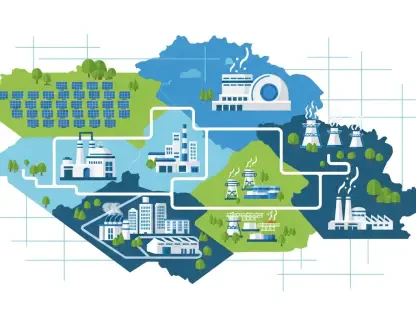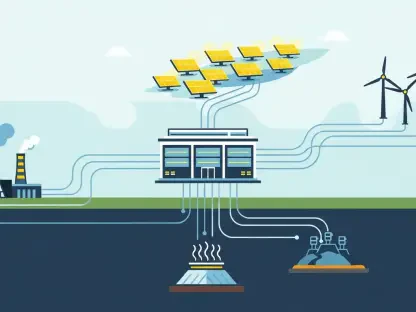As artificial intelligence continues to develop at an extraordinary pace, its energy requirements are charting a similar trajectory. This review explores how the expansion of AI technology is significantly impacting the UK’s energy infrastructure. Recently, the AI Energy Council’s dialogue reflected urgent needs to upgrade the National Grid, preparing to meet an anticipated twenty-fold rise in compute capacity within five years. This surge stems from the drive to maintain the UK’s competitive stance as an AI innovator while simultaneously addressing sustainability concerns.
The Nexus of AI and Energy
AI technology relies fundamentally on vast computational power. Essential for the training and deployment of AI models, this power largely determines the effectiveness and speed of AI-driven innovations, such as those seen in personalized medicine and sustainable aviation. The rapid integration of AI across sectors accentuates the importance of predicting and managing energy demand increases. During the council meeting, energy providers, tech firms, and government departments like Ofgem and the National Energy System Operator identified sectors ripe for accelerated AI adoption and resultant energy shifts. Precise forecasting and system readiness are crucial in preparing the grid for this new wave of energy-intensive AI applications.
Underpinning Development: Compute Capacity and Processing Power
The core of AI’s energy demands lies in its need for substantial compute capacity and processing prowess. These elements not only sustain current technologies but also spearhead forward-looking innovations. Processing power, measured through performance metrics, directly influences AI’s capabilities, enabling it to solve more complex tasks. Without strategic augmentation in computational resources, the growth expected in AI technology could face substantial barriers. Data-driven advancements and performance enhancements in processing units are indispensable for accommodating future innovations in AI.
Preparing Energy Systems for Future Requirements
Techniques for forecasting AI-induced energy consumption are evolving in response to emerging demands. Strategies involve not only ensuring adequate energy supply but also enhancing energy system adaptability to unforeseen spikes. The UK’s commitment, as illustrated by its £2 billion AI Opportunities Action Plan, highlights planned initiatives to support sustainable energy integration. Cooperative approaches seek to balance AI’s burgeoning needs with clean energy reliance, facilitating expansion without compromising energy security or environmental priorities.
Innovations Steering AI Energy Trends
Recent AI advancements contribute to altering the energy landscape. Developments in AI algorithms and hardware optimization have begun moderating energy usage, offsetting some of the expected demand surges. Emerging trends in AI adoption have lifted the veil on new opportunities and challenges, emphasizing the critical interplay between technology growth and resource management. These advancements reflect a broader intention to steer AI towards a symbiotic relationship with energy sectors, aiming to minimize ecological impact while advancing economic objectives.
Industry Applications and Their Energy Repercussions
Real-world applications of AI span multiple industries, each with distinct energy implications. In personalized medicine, AI offers transformative healthcare solutions, yet demands intricate computational processes. Similarly, AI’s role in sustainable aviation signals a shift toward greener innovation, although it too requires immense energy resources. By showcasing unique use cases, AI’s influence on energy consumption becomes more transparent, underscoring the need for integrated solutions that cater to specific industry needs without escalating energy concerns excessively.
Confronting Challenges in Managing AI Energy Demands
As AI’s energy requirements increase, technical, regulatory, and market challenges arise, demanding holistic responses. Addressing these challenges involves technological refinement and regulatory adjustments to encourage energy efficiency. Current efforts involve collaborative research and investment to drive sustainable practices. Industry engagement remains vital in overcoming limitations and ensuring AI’s growth aligns with societal expectations for cleaner and more efficient energy use.
Long-term Perspectives on AI Energy Consumption
Predicting the future of AI’s energy footprint involves considering potential breakthroughs and their ripple effects on broad industry practices. Long-term implications include redefining employment landscapes and advancing sustainable energy solutions. By understanding potential trajectories, industries can prepare for shifts, ensuring that readiness for AI’s growth aligns with continuous environmental stewardship. The journey toward balanced AI growth promises technological advancements aligning with resource sustainability.
Summary of Analysis and Reflections
Revisiting AI’s impact on energy dynamics reveals the intricate balance between technical innovation and resource management. The discussion underscored the criticality of compute power, strategic energy forecasting, and adaptive infrastructure development. Challenges, while substantial, underline the commitment to leveraging AI responsibly within environmental constraints. AI’s trajectory involves fostering technological progress, securing energy stability, and enhancing societal benefits, emphasizing continued collaboration across sectors to maintain momentum toward sustainable development.









